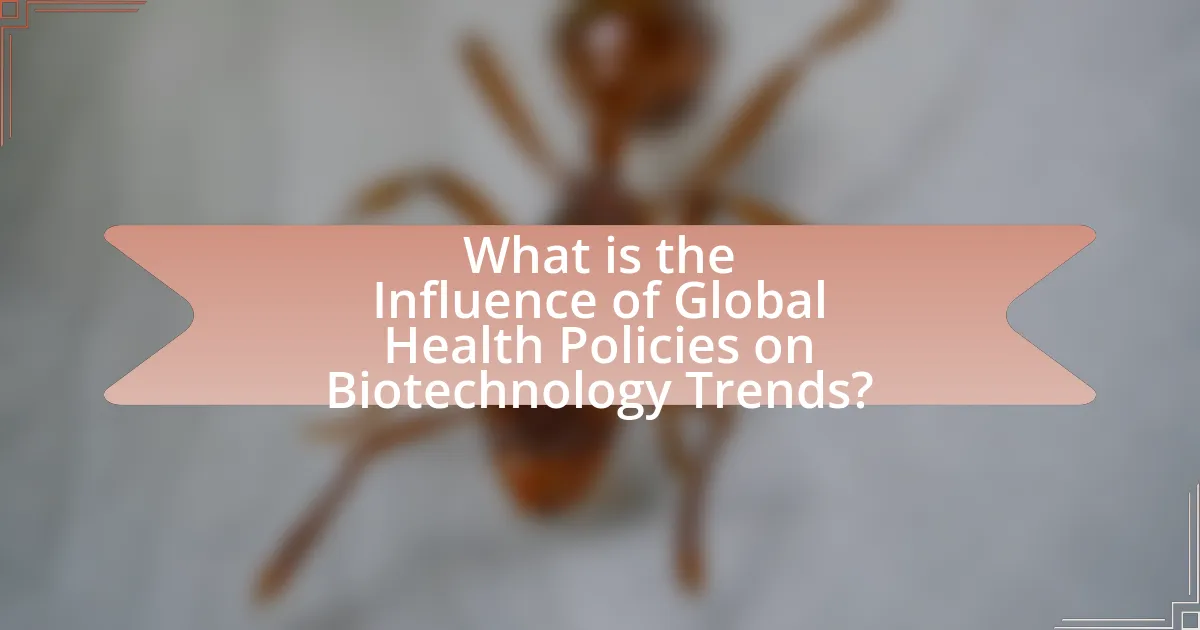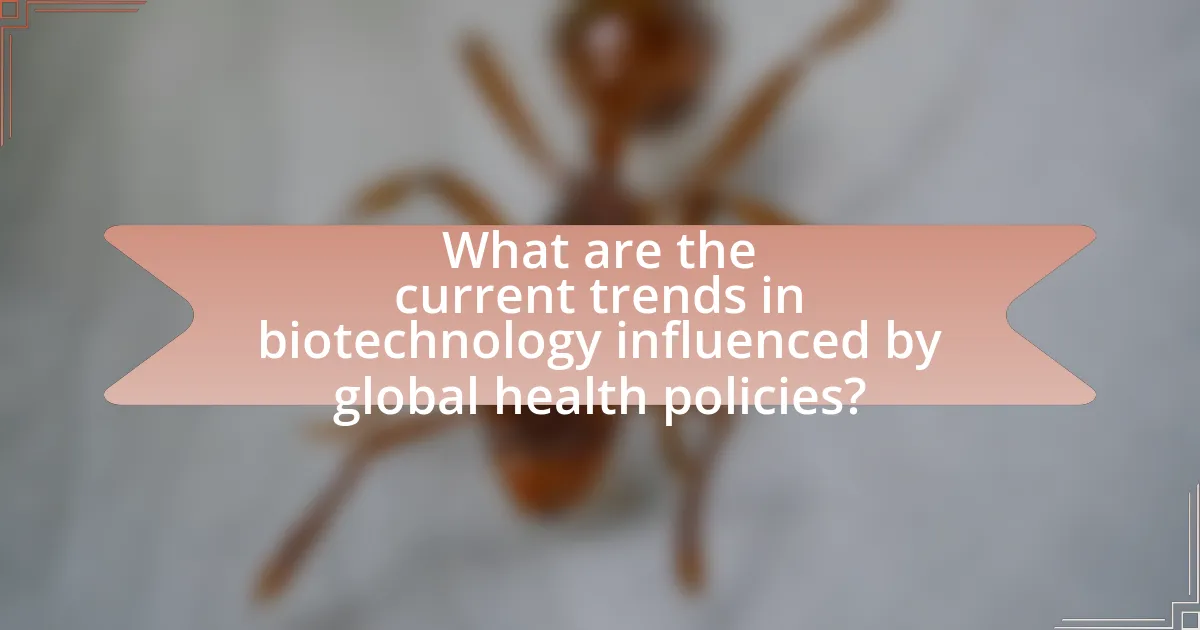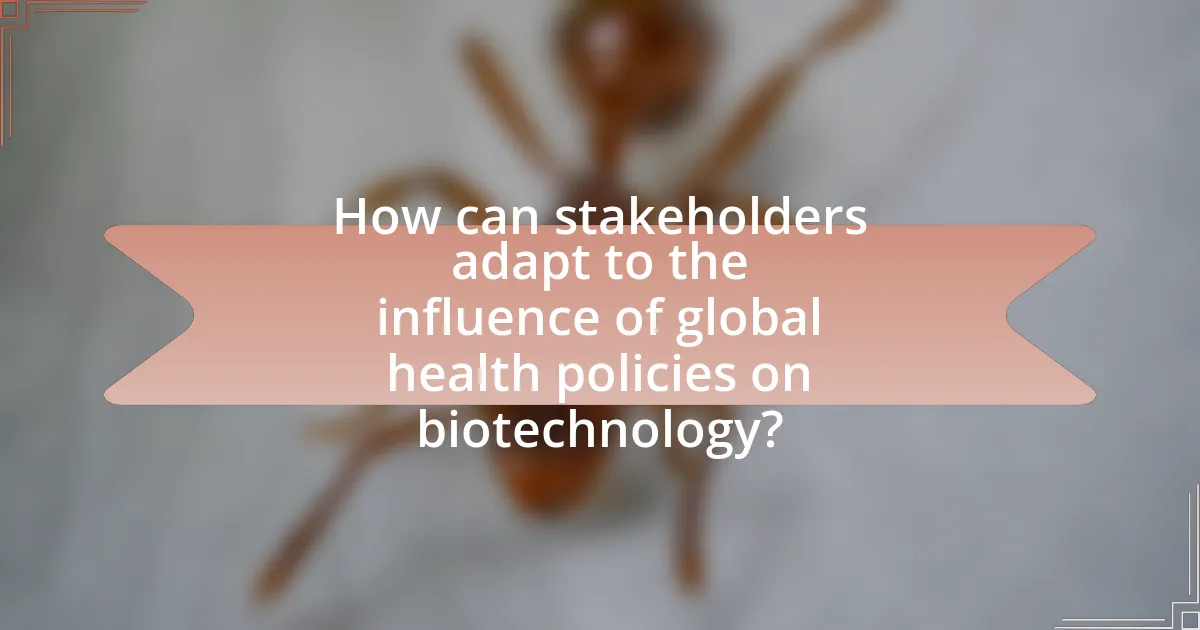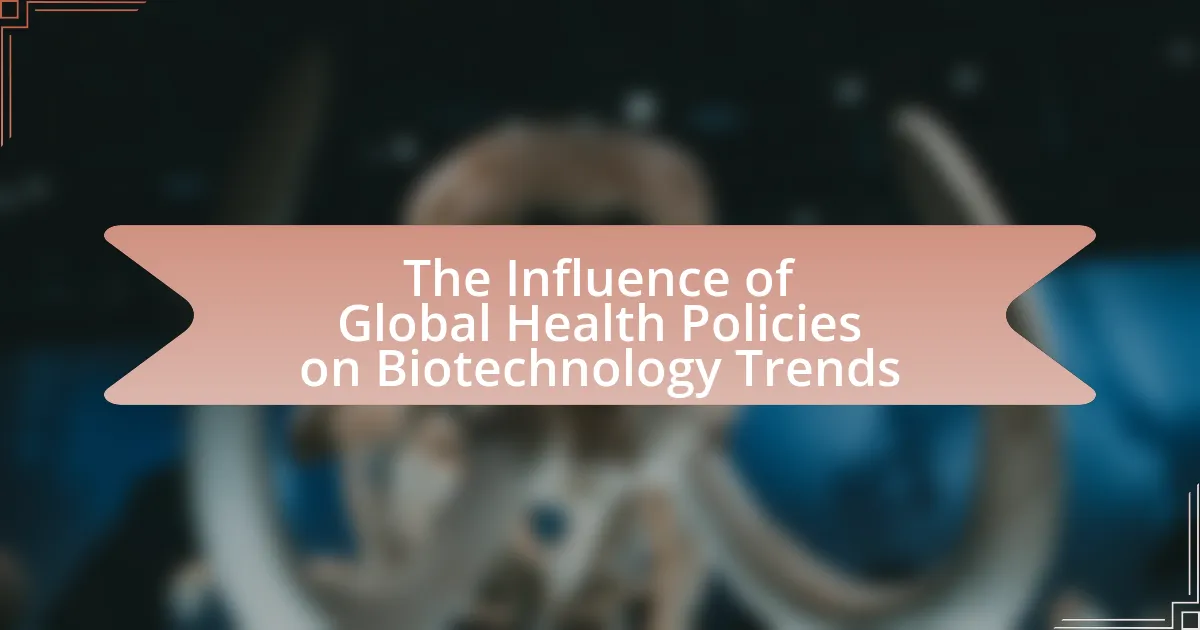The article examines the significant influence of global health policies on biotechnology trends, highlighting how these policies shape research priorities, funding allocations, and regulatory frameworks. It discusses key policies such as the World Health Organization’s Global Strategy and the Nagoya Protocol, which drive innovation in areas like vaccine development and personalized medicine. The article also addresses the implications of funding disparities, compliance requirements, and the role of stakeholders in adapting to these influences, ultimately emphasizing the importance of understanding these dynamics for advancing biotechnological solutions to global health challenges.

What is the Influence of Global Health Policies on Biotechnology Trends?
Global health policies significantly influence biotechnology trends by shaping research priorities, funding allocations, and regulatory frameworks. For instance, initiatives like the Global Health Security Agenda prioritize infectious disease research, driving biotechnological advancements in vaccine development and diagnostics. Additionally, funding from organizations such as the World Health Organization and the Bill & Melinda Gates Foundation directs resources toward biotechnological innovations that address global health challenges, such as malaria and HIV. These policies also establish regulatory standards that biotechnology companies must meet, impacting the speed and direction of product development. Thus, global health policies play a crucial role in determining the focus and pace of biotechnological advancements.
How do global health policies shape biotechnology innovations?
Global health policies significantly shape biotechnology innovations by establishing regulatory frameworks, funding priorities, and research agendas that guide the development and application of biotechnological solutions. For instance, the World Health Organization’s Global Strategy and Plan of Action on Public Health, Innovation and Intellectual Property emphasizes the need for innovative health technologies, which incentivizes biotechnological research aimed at addressing global health challenges such as infectious diseases and chronic conditions. Additionally, policies like the U.S. National Institutes of Health’s funding initiatives prioritize research in areas like genomics and personalized medicine, directly influencing the direction of biotechnology innovations. These policies create an environment that fosters collaboration between governments, private sectors, and academic institutions, ultimately driving advancements in biotechnology that align with public health goals.
What are the key global health policies impacting biotechnology?
Key global health policies impacting biotechnology include the World Health Organization’s Global Strategy and Plan of Action on Public Health, Innovation and Intellectual Property, which aims to enhance research and development in biotechnology for health. Additionally, the Nagoya Protocol on Access and Benefit-sharing influences biotechnological research by regulating the use of genetic resources and ensuring fair sharing of benefits derived from them. The International Health Regulations also play a critical role by establishing frameworks for global health security, which can drive biotechnological innovations in response to health emergencies. These policies collectively shape the landscape of biotechnology by promoting innovation, ensuring ethical practices, and addressing public health needs.
How do these policies drive research and development in biotechnology?
Global health policies drive research and development in biotechnology by providing funding, regulatory frameworks, and incentives that promote innovation. For instance, policies such as the Affordable Care Act in the United States have allocated billions in funding for biomedical research, which has directly supported advancements in biotechnology. Additionally, regulatory frameworks established by agencies like the FDA streamline the approval process for biotechnological products, encouraging companies to invest in R&D. Furthermore, tax incentives and grants for biotech startups foster an environment conducive to innovation, as evidenced by the increase in biotech patents filed in response to supportive policies.
Why is understanding this influence important for stakeholders?
Understanding the influence of global health policies on biotechnology trends is crucial for stakeholders because it directly impacts their strategic decisions and investments. Stakeholders, including investors, researchers, and policymakers, must recognize how these policies shape market dynamics, regulatory environments, and funding opportunities. For instance, the World Health Organization’s initiatives can drive innovation in biotechnology by prioritizing certain health challenges, leading to increased funding and research focus in those areas. This understanding enables stakeholders to align their objectives with emerging trends, ensuring they remain competitive and responsive to market needs.
Who are the primary stakeholders affected by these policies?
The primary stakeholders affected by global health policies in biotechnology are governments, healthcare providers, pharmaceutical companies, biotechnology firms, and patients. Governments shape regulations and funding, impacting the operational landscape for biotechnology firms. Healthcare providers rely on these policies to guide treatment protocols and access to innovations. Pharmaceutical companies are influenced by regulatory frameworks that dictate drug approval processes and market access. Biotechnology firms must adapt to compliance requirements and funding opportunities created by these policies. Lastly, patients are directly affected as these policies determine the availability and affordability of biotechnological advancements in healthcare.
What are the potential consequences of ignoring these influences?
Ignoring the influences of global health policies on biotechnology trends can lead to significant setbacks in public health outcomes and innovation. For instance, without adherence to these policies, biotechnological advancements may not align with regulatory standards, resulting in delayed product approvals and increased risks to patient safety. A study by the World Health Organization indicates that countries that fail to integrate health policies into their biotechnology sectors experience higher rates of disease outbreaks and lower vaccination coverage, which can exacerbate public health crises. Additionally, neglecting these influences can stifle investment in biotechnology, as investors often seek environments with clear regulatory frameworks. This lack of investment can hinder research and development, ultimately slowing progress in addressing global health challenges.

What are the current trends in biotechnology influenced by global health policies?
Current trends in biotechnology influenced by global health policies include the accelerated development of mRNA vaccines, advancements in gene editing technologies like CRISPR, and increased focus on personalized medicine. The COVID-19 pandemic highlighted the importance of rapid vaccine development, leading to a surge in mRNA technology, which was utilized in vaccines by companies such as Pfizer-BioNTech and Moderna. Additionally, global health policies are promoting equitable access to biotechnological innovations, as seen in initiatives like COVAX, which aims to ensure vaccine distribution to low- and middle-income countries. Furthermore, regulatory frameworks are evolving to support the integration of artificial intelligence in drug discovery and diagnostics, enhancing the efficiency of biotechnological applications. These trends reflect a direct response to global health challenges and the need for innovative solutions in healthcare.
How do regulatory frameworks affect biotechnology advancements?
Regulatory frameworks significantly influence biotechnology advancements by establishing guidelines that govern research, development, and commercialization processes. These frameworks ensure safety, efficacy, and ethical standards, which can either facilitate or hinder innovation. For instance, stringent regulations may delay product approvals, as seen in the lengthy review processes for genetically modified organisms (GMOs) in various countries, impacting the speed at which new biotechnological solutions reach the market. Conversely, supportive regulatory environments, such as the expedited pathways for COVID-19 vaccine approvals by agencies like the FDA, can accelerate advancements and foster rapid innovation in biotechnology.
What specific regulations are most impactful on biotechnology trends?
The specific regulations most impactful on biotechnology trends include the FDA’s guidelines on gene editing, the European Union’s General Data Protection Regulation (GDPR), and the National Institutes of Health (NIH) funding policies. The FDA’s guidelines shape the development and approval processes for genetically modified organisms, influencing innovation and market entry. The GDPR affects data handling in biotechnological research, particularly in genetic data, thereby impacting research methodologies and collaboration. NIH funding policies dictate the allocation of resources for biotechnology research, directly influencing the direction and focus of scientific advancements. These regulations collectively shape the landscape of biotechnology by establishing standards that govern safety, ethical considerations, and funding priorities.
How do compliance requirements shape innovation in biotechnology?
Compliance requirements significantly shape innovation in biotechnology by establishing regulatory frameworks that guide research and development processes. These regulations ensure safety, efficacy, and ethical standards, which can drive companies to innovate in ways that align with compliance, such as developing new technologies for faster testing or more efficient production methods. For instance, the FDA’s stringent approval processes encourage biotechnological firms to invest in advanced data analytics and automation to streamline compliance, ultimately leading to innovative solutions that enhance product development timelines.
What role does funding play in biotechnology under global health policies?
Funding is crucial in biotechnology under global health policies as it enables research, development, and implementation of innovative health solutions. Financial resources support the advancement of biotechnological products, such as vaccines and therapeutics, which are essential for addressing global health challenges like pandemics and endemic diseases. For instance, the Coalition for Epidemic Preparedness Innovations (CEPI) has mobilized over $1 billion to accelerate vaccine development for infectious diseases, demonstrating how targeted funding can enhance global health preparedness. Additionally, investments from public and private sectors drive collaboration among researchers, governments, and organizations, fostering an environment conducive to innovation and rapid response to health crises.
How do international funding initiatives support biotechnology research?
International funding initiatives support biotechnology research by providing essential financial resources that enable innovation and development in the field. These initiatives, such as the Global Fund and the European Union’s Horizon programs, allocate significant budgets to research projects, facilitating advancements in areas like drug development, agricultural biotechnology, and disease prevention. For instance, the European Union’s Horizon 2020 program has invested over €80 billion from 2014 to 2020 to promote research and innovation, directly impacting biotechnology advancements. This funding not only supports individual research projects but also fosters international collaboration, allowing researchers from different countries to share knowledge and resources, thereby accelerating the pace of biotechnological breakthroughs.
What are the implications of funding disparities on biotechnology trends?
Funding disparities significantly impact biotechnology trends by creating uneven access to resources, which can hinder innovation and development in the sector. For instance, regions with higher funding often see accelerated advancements in research and product development, while those with limited financial support struggle to keep pace, leading to a concentration of biotechnological advancements in wealthier areas. According to a report by the National Institutes of Health, disparities in funding can result in a 30% slower rate of innovation in underfunded regions compared to their better-funded counterparts. This uneven landscape not only affects the availability of new therapies and technologies but also exacerbates global health inequalities, as populations in less funded areas may lack access to critical biotechnological solutions.

How can stakeholders adapt to the influence of global health policies on biotechnology?
Stakeholders can adapt to the influence of global health policies on biotechnology by actively engaging in policy advocacy and aligning their research and development strategies with regulatory frameworks. This approach allows stakeholders, such as biotech companies and research institutions, to anticipate changes in policy and ensure compliance, thereby facilitating smoother market entry for new products. For instance, the implementation of the World Health Organization’s Global Strategy and Plan of Action on Public Health, Innovation and Intellectual Property encourages stakeholders to focus on innovation that addresses public health needs, which can lead to increased funding and collaboration opportunities. By staying informed about global health trends and participating in international discussions, stakeholders can better position themselves to respond to evolving policies and leverage them for strategic advantage.
What strategies can companies employ to align with health policies?
Companies can employ strategies such as adopting compliance frameworks, engaging in stakeholder collaboration, and investing in research and development to align with health policies. Compliance frameworks ensure that companies adhere to regulations and standards set by health authorities, which is crucial for maintaining operational legitimacy. Engaging with stakeholders, including government agencies, healthcare providers, and community organizations, fosters a collaborative approach that can influence policy development and implementation. Additionally, investing in research and development allows companies to innovate solutions that meet health policy objectives, such as improving patient outcomes or addressing public health challenges. These strategies are supported by the fact that organizations actively involved in policy discussions and compliance tend to have better market positioning and access to funding opportunities, as evidenced by studies showing that companies aligned with health policies experience enhanced credibility and trust within the healthcare ecosystem.
How can biotechnology firms leverage policy changes for growth?
Biotechnology firms can leverage policy changes for growth by aligning their research and development efforts with new regulations and funding opportunities. For instance, when governments introduce policies that promote innovation in healthcare, such as increased funding for biotechnology research or streamlined approval processes for new therapies, firms can capitalize on these changes by accelerating their product development timelines. A concrete example is the U.S. government’s 21st Century Cures Act, which provided significant funding for biomedical research and expedited the approval of new drugs, allowing biotechnology firms to bring their products to market more quickly and efficiently. This alignment not only enhances their competitive advantage but also attracts investment, as stakeholders are more likely to support companies that are positioned to benefit from favorable policy environments.
What best practices should be adopted to navigate regulatory landscapes?
To navigate regulatory landscapes effectively, organizations should adopt a proactive compliance strategy that includes continuous monitoring of regulations, engaging with regulatory bodies, and implementing robust internal policies. Continuous monitoring ensures that organizations stay updated on changes in laws and regulations, which is crucial in the rapidly evolving biotechnology sector. Engaging with regulatory bodies fosters relationships that can provide insights into regulatory expectations and facilitate smoother approval processes. Implementing robust internal policies ensures that all employees understand compliance requirements, reducing the risk of violations. According to a study by the Regulatory Affairs Professionals Society, organizations that actively engage with regulators and maintain compliance frameworks experience fewer delays in product approvals, highlighting the importance of these best practices.
What are the future implications of global health policies on biotechnology trends?
Future global health policies will significantly shape biotechnology trends by prioritizing innovation in vaccine development, personalized medicine, and regulatory frameworks. For instance, the COVID-19 pandemic has accelerated investments in mRNA technology, leading to a surge in vaccine research and development, which is likely to continue as governments emphasize preparedness for future pandemics. Additionally, policies promoting equitable access to biotechnological advancements will drive the creation of affordable therapies and diagnostics, particularly in low- and middle-income countries. This shift is supported by initiatives like the World Health Organization’s Access to COVID-19 Tools (ACT) Accelerator, which aims to ensure global access to vaccines and treatments. Furthermore, regulatory harmonization across countries will facilitate faster approval processes for biotechnological products, enhancing collaboration and innovation in the sector.
How might emerging health challenges reshape biotechnology priorities?
Emerging health challenges, such as pandemics and antibiotic resistance, are likely to reshape biotechnology priorities by driving increased investment in rapid diagnostics, vaccine development, and innovative therapeutics. For instance, the COVID-19 pandemic accelerated the focus on mRNA technology, leading to the rapid development of effective vaccines, which has now become a priority area for future biotechnological advancements. Additionally, the rise of antibiotic-resistant bacteria has prompted biotechnology firms to prioritize research into novel antimicrobial agents and alternative therapies, as evidenced by the World Health Organization’s report highlighting the urgent need for new antibiotics. This shift in focus reflects a direct response to pressing global health needs, influencing funding, research agendas, and collaborative efforts within the biotechnology sector.
What trends should stakeholders monitor for future developments?
Stakeholders should monitor the trend of increased investment in biotechnology driven by global health policies. This trend is evidenced by the significant funding allocated to vaccine development and research in response to the COVID-19 pandemic, which saw global investment in biotechnology reach over $200 billion in 2021, according to the Biotechnology Innovation Organization. Additionally, stakeholders should observe the regulatory changes aimed at accelerating the approval processes for biopharmaceuticals, as seen in the Emergency Use Authorization protocols implemented by various health authorities. These developments indicate a shift towards more agile and responsive biotechnology sectors, influenced by the need for rapid health solutions.
What practical steps can stakeholders take to stay informed and proactive?
Stakeholders can stay informed and proactive by regularly engaging with industry reports, attending relevant conferences, and participating in policy discussions. Engaging with industry reports, such as those published by the World Health Organization or the Biotechnology Innovation Organization, provides insights into current trends and regulatory changes. Attending conferences like the BIO International Convention allows stakeholders to network with experts and gain firsthand knowledge of emerging technologies and policies. Additionally, participating in policy discussions through forums or working groups enables stakeholders to influence and adapt to changes in global health policies that impact biotechnology.


